

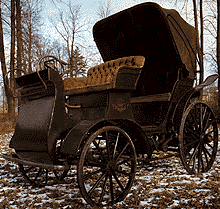 In 1897, Nesselsdorfer Wagenbau obtained a Benz automobile and two-cylinder engine for investigation by its engineers. The interest in possible automobile production seemed to have been sparked by the exploits of Baron Theodor von Liebeg, an Austrian textile magnate who happened to be an avid sporting motorist. He owned one of the first of the Benz one-cylinder 3bhp Victorias and drove it a distance of almost 1000 km across a part of Europe. In 1895 he was introduced to von Roslerstamm, chief manager of Nesselsdorfer Wagenbau, and described his incredible journey to him. Engineers Edmund Rumpler (who would later become one of the pioneers of automobile aerodynamics, among other things) and Sage, works manager Leopold Svitak, and the boss himself conducted a detailed analysis of the Benz, as a very young (19 at the time) engineering student by the name of Hans Ledwinka looked on from the distance. Ledwinka was employed in the railway division of NW but became extremely fascinated with automobiles. It was decided to construct a car, to be called President, largely based on the design of the Benz. The 6bhp (@ 600rpm) 2.7-litre water-cooled two-cylinder Benz engine was mounted in the rear of the chassis, power being transmitted by two belts to a differential-gear-equipped countershaft, which drove the rear wheels by chains. Rumpler and Sage were responsible for the design, but Ledwinka may have had a hand in it. The president, with a claimed top speed of 35 km/h, was shown publicly in late 1897 at an exhibition in Vienna and a decision was made to build ten more cars, albeit with some modifications. Chain drive replaced belts, the gear lever was now floor mounted, and a four-speed transmission and pneumatic tires were utilized. A problem was found with the gearbox setup, however, and with Rumpler and Sage having left NW, Ledwinka got the job of re-designing the transmission. That must have fixed the problem as the ten cars were completed as planned.
In 1897, Nesselsdorfer Wagenbau obtained a Benz automobile and two-cylinder engine for investigation by its engineers. The interest in possible automobile production seemed to have been sparked by the exploits of Baron Theodor von Liebeg, an Austrian textile magnate who happened to be an avid sporting motorist. He owned one of the first of the Benz one-cylinder 3bhp Victorias and drove it a distance of almost 1000 km across a part of Europe. In 1895 he was introduced to von Roslerstamm, chief manager of Nesselsdorfer Wagenbau, and described his incredible journey to him. Engineers Edmund Rumpler (who would later become one of the pioneers of automobile aerodynamics, among other things) and Sage, works manager Leopold Svitak, and the boss himself conducted a detailed analysis of the Benz, as a very young (19 at the time) engineering student by the name of Hans Ledwinka looked on from the distance. Ledwinka was employed in the railway division of NW but became extremely fascinated with automobiles. It was decided to construct a car, to be called President, largely based on the design of the Benz. The 6bhp (@ 600rpm) 2.7-litre water-cooled two-cylinder Benz engine was mounted in the rear of the chassis, power being transmitted by two belts to a differential-gear-equipped countershaft, which drove the rear wheels by chains. Rumpler and Sage were responsible for the design, but Ledwinka may have had a hand in it. The president, with a claimed top speed of 35 km/h, was shown publicly in late 1897 at an exhibition in Vienna and a decision was made to build ten more cars, albeit with some modifications. Chain drive replaced belts, the gear lever was now floor mounted, and a four-speed transmission and pneumatic tires were utilized. A problem was found with the gearbox setup, however, and with Rumpler and Sage having left NW, Ledwinka got the job of re-designing the transmission. That must have fixed the problem as the ten cars were completed as planned.
In 1898, Baron von Liebieg took the President for a spin on country roads from Nesselsdorf to Vienna at an average speed of about 17 km/h, without any troubles. The following year he pushed NW to go racing, which was carried out in regular cars for the time being. But the next year Hans Ledwinka, who put himself into an unofficial position as the chief of automobile design, devised a body-less racer called the Rennzweier, with a 12bhp (@ 1800rpm) 4.2-litre flat-twin Benz-type engine and a max. speed of 82 km/h, for the purpose. The results weren't extraordinary but some first, second, and third places were attained in various events. Management, however, was not particularly thrilled with the idea of racing and it was stopped.
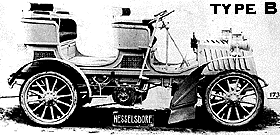
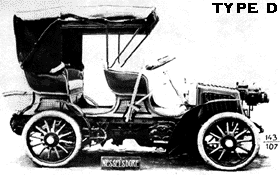 The 1900 Type A, of which 22 were made, should probably be considered the first true Nesselsdorfer production automobile. Designed by Ledwinka, it's rear-mounted motor now producing 9bhp @ 1400rpm and propelling it to a maximum speed of 40 km/h. Also that year (1900) one Tourenwagen (possibly for racing), with specs identical to the A, was constructed. After this Ledwinka designed the B, which was capable of 45 km/h from a centrally mounted 12bhp 3.2-litre powerplant. It went into production in 1902, just as Ledwinka was having doubts about internal combustion and left the company to work with steam. Production of the B ceased in 1904 after 38 had been made. Two examples of the C, powered by a 24bhp (@ 1300rpm) 5.9-litre flat-4 engine, were built in 1902 as well. The D of 1904 was equipped with a similar engine, 12 were produced. Then came 8 examples of the E, with a 18bhp 3.8-litre 2-cylinder motor, and this was followed in '06 by 3 examples of the F, with a 35bhp 7.5-litre flat-4.
The 1900 Type A, of which 22 were made, should probably be considered the first true Nesselsdorfer production automobile. Designed by Ledwinka, it's rear-mounted motor now producing 9bhp @ 1400rpm and propelling it to a maximum speed of 40 km/h. Also that year (1900) one Tourenwagen (possibly for racing), with specs identical to the A, was constructed. After this Ledwinka designed the B, which was capable of 45 km/h from a centrally mounted 12bhp 3.2-litre powerplant. It went into production in 1902, just as Ledwinka was having doubts about internal combustion and left the company to work with steam. Production of the B ceased in 1904 after 38 had been made. Two examples of the C, powered by a 24bhp (@ 1300rpm) 5.9-litre flat-4 engine, were built in 1902 as well. The D of 1904 was equipped with a similar engine, 12 were produced. Then came 8 examples of the E, with a 18bhp 3.8-litre 2-cylinder motor, and this was followed in '06 by 3 examples of the F, with a 35bhp 7.5-litre flat-4.

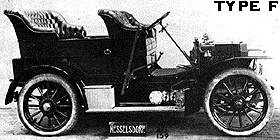
 During those years there was more and more criticism of the Nesselsdorfer vehicles, largely due to the unsatisfactory (and unreliable) central placement of the motor, which was practically inaccessible without taking the car to pieces. These problems were certainly reflected in the low sales. To try to rectify the situation, 2 engineers with the names Kronfeld and Lang were hired with the task of designing, independently, a better Nesselsdorfer. Kronfeld designed the J, which had a front-mounted 35bhp 5.9-litre 4-cyl. engine and magneto ignition, and 11 were built between 1906 and '08. Lang, on the other hand, designed the L, equipped with shaftdrive and a front-mounted 29bhp 4.5-litre side-valve four. Both the J and the L were very heavy and therefore underpowered. Management was not happy with the designs and the engineers left. Nesselsdorfer Wagenbau needed Hans Ledwinka and tried to bring him back. This was not difficult since his work with steam had not gotten him very far and NW works manager Leopold Svitak, who was often at odds with him, was retiring.
During those years there was more and more criticism of the Nesselsdorfer vehicles, largely due to the unsatisfactory (and unreliable) central placement of the motor, which was practically inaccessible without taking the car to pieces. These problems were certainly reflected in the low sales. To try to rectify the situation, 2 engineers with the names Kronfeld and Lang were hired with the task of designing, independently, a better Nesselsdorfer. Kronfeld designed the J, which had a front-mounted 35bhp 5.9-litre 4-cyl. engine and magneto ignition, and 11 were built between 1906 and '08. Lang, on the other hand, designed the L, equipped with shaftdrive and a front-mounted 29bhp 4.5-litre side-valve four. Both the J and the L were very heavy and therefore underpowered. Management was not happy with the designs and the engineers left. Nesselsdorfer Wagenbau needed Hans Ledwinka and tried to bring him back. This was not difficult since his work with steam had not gotten him very far and NW works manager Leopold Svitak, who was often at odds with him, was retiring.
 Upon his return to NW in late 1905, Hans Ledwinka found the automobile division in a bleak situation, with the poorly designed J and L and with the threat of closing down hanging over it. Then officially the director of the car division, he decided to scrap those designs and design a completely new automobile, to be called the Type S.
Upon his return to NW in late 1905, Hans Ledwinka found the automobile division in a bleak situation, with the poorly designed J and L and with the threat of closing down hanging over it. Then officially the director of the car division, he decided to scrap those designs and design a completely new automobile, to be called the Type S.
 The S prototype, powered by an advanced 3.3-litre 3-main-bearings overhead-valve OHC four-cylinder engine with hemispherical combustion chambers and a 30bhp output at 2200rpm, rode on a chassis with a wheelbase of 310 cm and was capable of a top speed of 90 km/h. The design and construction of the prototype was done practically in secret and, once completed, the S was shown to von Roslerstamm, who thought hard and eventually allowed it to proceed to the production stage. This was reached in 1909 and 37 examples, in several body styles, left the factory. A version of the S with a 5-litre 50bhp six-cylinder powerplant, a max. speed of 110 km/h, and a longer 34.5cm wheelbase was also produced, from 1911, in a quantity of ten. Finally, it seems, Nesselsdorfer Wagenbau was offering very good automobiles and that future car-making was assured, due to Ledwinka's great engineering and strategic abilities.
The S prototype, powered by an advanced 3.3-litre 3-main-bearings overhead-valve OHC four-cylinder engine with hemispherical combustion chambers and a 30bhp output at 2200rpm, rode on a chassis with a wheelbase of 310 cm and was capable of a top speed of 90 km/h. The design and construction of the prototype was done practically in secret and, once completed, the S was shown to von Roslerstamm, who thought hard and eventually allowed it to proceed to the production stage. This was reached in 1909 and 37 examples, in several body styles, left the factory. A version of the S with a 5-litre 50bhp six-cylinder powerplant, a max. speed of 110 km/h, and a longer 34.5cm wheelbase was also produced, from 1911, in a quantity of ten. Finally, it seems, Nesselsdorfer Wagenbau was offering very good automobiles and that future car-making was assured, due to Ledwinka's great engineering and strategic abilities.
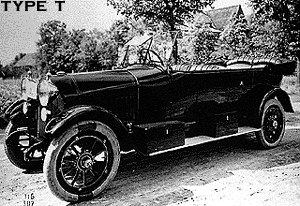 Nineteen-twelwe was a dark year for NW, due to a five month labour strike.
Nineteen-twelwe was a dark year for NW, due to a five month labour strike.
In 1914 the type S was replaced by the T, similar to the 4-cylinder S but slightly larger and powered by a 44bhp 3.6-litre monobloc four. Fuel economy was not bad, at about 15 l of petrol per 100 km. The T was later renamed T21 and was produced until 1922. A racing version of it appeared in '21 with a higher top speed. The following year (1915) came the Type U, propelled to 120 km/h by a 5.3-litre six with an ouput of 55bhp and riding on a 36.3cm wheelbase. It was remained in production until 1925 as type T10, a 140 km/h racing version was made in '21.
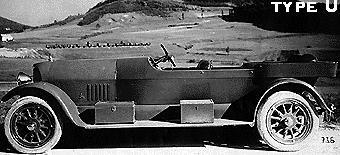 Nesselsdorf production was growing respectfully during the teens and had outgrown the factory by 1915. Money was required to enlarge the production facilities, but that was not a problem as von Roslerstamm was extremely pleased with the progress at the automobile division. Von Roslerstamm set aside the funds but retired from NW due to various reasons, not the least of which was the strike a few years previous.
Nesselsdorf production was growing respectfully during the teens and had outgrown the factory by 1915. Money was required to enlarge the production facilities, but that was not a problem as von Roslerstamm was extremely pleased with the progress at the automobile division. Von Roslerstamm set aside the funds but retired from NW due to various reasons, not the least of which was the strike a few years previous.
The good atmosphere at Nesselsdorfer was shattered when Erhard Kobel, the new boss, took this money and built a railroad car factory instead. Ledwinka obviously became absolutely furious and once again left, this time for the Steyr.
It was then 1916 and Europe was in the depths of the World War I, which had began two years earlier...